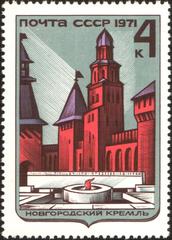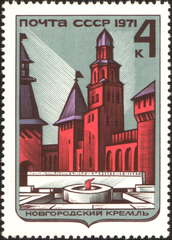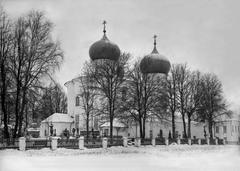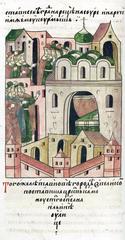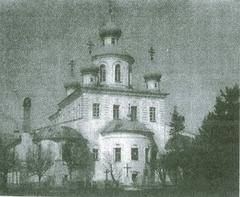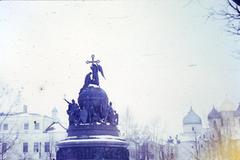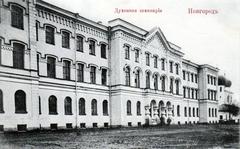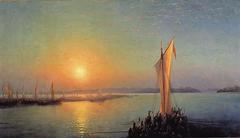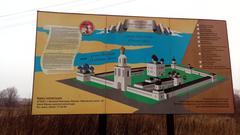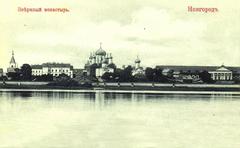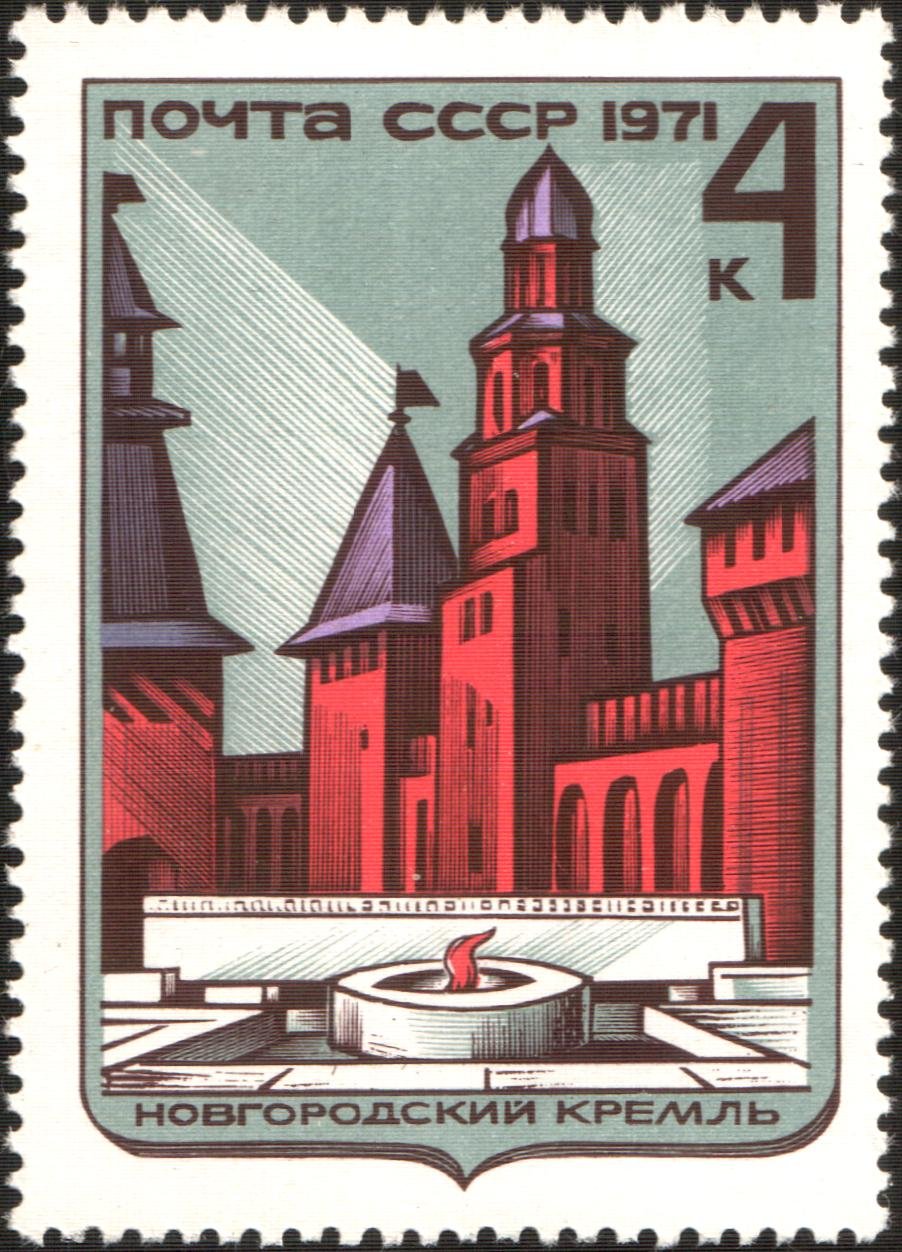
Visiting Hours, Tickets, and History of Новгородский кремль in Veliky Novgorod, Russia
Date: 31/07/2024
Introduction
The Новгородский кремль, also known as the Novgorod Kremlin or Detinets, is one of the oldest and most significant fortresses in Russia. Located on the left bank of the Volkhov River in Veliky Novgorod, this historic site dates back to the 11th century and has played a pivotal role in the political, religious, and cultural life of the region. Initially constructed from wood under the rule of Prince Yaroslav the Wise, it was later transformed into a stone and brick fortress in the 14th century (Britannica).
The Novgorod Kremlin has witnessed numerous historical events, from its early beginnings as a defensive structure to its role as the center of the Novgorod Republic, a quasi-democratic state that existed from the 12th to the 15th century (Visit Novgorod). This fortress also became a member of the Hanseatic League, significantly boosting Novgorod’s economic status and making it a vital trade hub between Russia and Europe. Today, the Kremlin stands as a testament to the resilience and creativity of the people of Novgorod and continues to be a major tourist attraction and a UNESCO World Heritage site (RBTH).
This comprehensive guide will delve into the rich history, architectural evolution, and modern-day relevance of the Novgorod Kremlin. It will also provide practical information for visitors, including ticket prices, opening hours, travel tips, and nearby attractions. Whether you’re a history enthusiast, an architecture aficionado, or a curious traveler, the Novgorod Kremlin offers a captivating journey through Russia’s rich past.
Table of Contents
- Introduction
- History of Новгородский кремль (Novgorod Kremlin), Veliky Novgorod, Russia
- Visitor Information
- FAQ
- Conclusion
History of Новгородский кремль (Novgorod Kremlin), Veliky Novgorod, Russia
Early Beginnings and Construction
The Новгородский кремль, also known as the Novgorod Kremlin or Detinets, is one of the oldest and most significant fortresses in Russia. Its origins date back to the 11th century, making it a crucial part of Russian history. The initial construction began in 1044 under the rule of Prince Yaroslav the Wise. This early version was primarily built from wood and served as a defensive structure to protect the burgeoning city of Novgorod from external threats.
Architectural Evolution
The wooden fortifications of the Novgorod Kremlin were replaced with stone and brick structures in the 14th century. This transformation was part of a broader trend in medieval Russia, where wooden fortresses were gradually replaced with more durable materials. The stone Kremlin we see today began to take shape during this period, with significant contributions from various rulers who recognized the strategic importance of Novgorod.
One of the most notable architectural features of the Novgorod Kremlin is the Saint Sophia Cathedral, constructed between 1045 and 1050. This cathedral is the oldest church in Russia still standing in its original form and is a UNESCO World Heritage site. The cathedral’s construction marked a significant milestone in the architectural and cultural development of Novgorod, symbolizing the city’s growing importance as a religious and political center.
Role in Medieval Russia
Throughout the medieval period, the Novgorod Kremlin played a pivotal role in the political and military affairs of Russia. Novgorod was a major center of trade, culture, and governance, and the Kremlin was at the heart of these activities. The fortress served as the residence of the Novgorod princes and the archbishops, who wielded considerable influence over the city’s affairs.
The Novgorod Kremlin was also a focal point during the conflicts between Novgorod and other Russian principalities, as well as external invaders. Its robust fortifications and strategic location on the banks of the Volkhov River made it a formidable stronghold. The Kremlin’s walls and towers were continually reinforced and expanded to withstand sieges and attacks, reflecting the turbulent nature of the medieval period.
The Hanseatic League and Economic Significance
In the 13th and 14th centuries, Novgorod became a member of the Hanseatic League, a powerful economic and defensive alliance of merchant guilds and market towns in Northwestern and Central Europe. This membership significantly boosted Novgorod’s economic status, making it a vital hub for trade between Russia and Europe. The Novgorod Kremlin, with its strategic location and robust defenses, played a crucial role in protecting the city’s economic interests.
The marketplace within the Kremlin walls was one of the largest on the trade route from the Varangians to the Greeks, dealing in a vast array of goods, including fur, honey, and wax. The economic prosperity brought by the Hanseatic League further cemented the Kremlin’s importance as a center of commerce and governance.
The Time of Troubles and Decline
The late 16th and early 17th centuries were a period of significant turmoil for Novgorod and its Kremlin. The Time of Troubles, a period of political crisis and foreign invasion in Russia, had a profound impact on the city. In 1611, Novgorod was occupied by Swedish forces, and the Kremlin suffered considerable damage during this period.
Despite these challenges, the Novgorod Kremlin remained a symbol of resilience and continuity. Efforts were made to restore and maintain the fortress, reflecting its enduring significance in Russian history. However, the political and economic decline of Novgorod in the 17th century led to a gradual reduction in the Kremlin’s prominence.
Restoration and Modern Era
The 20th century saw renewed interest in the preservation and restoration of the Novgorod Kremlin. During the Soviet era, significant efforts were made to restore the fortress and its historic buildings. These efforts were part of a broader initiative to preserve Russia’s cultural heritage and promote national identity.
In recent years, the Novgorod Kremlin has undergone extensive restoration work to ensure its preservation for future generations. These efforts have included the restoration of the Kremlin’s walls, towers, and historic buildings, as well as the conservation of its invaluable cultural artifacts. The Kremlin is now a major tourist attraction, drawing visitors from around the world who come to explore its rich history and architectural splendor.
Cultural and Historical Significance
The Novgorod Kremlin is not only a symbol of Novgorod’s historical importance but also a testament to the city’s cultural and architectural achievements. The fortress houses several museums and cultural institutions that showcase the rich history and heritage of Novgorod. Among these is the Novgorod State United Museum, which features extensive collections of medieval art, manuscripts, and artifacts.
The Saint Sophia Cathedral, with its stunning frescoes and ancient icons, remains one of the most significant cultural landmarks within the Kremlin. The cathedral’s interior is adorned with frescoes dating back to the 11th century, including the famous frescoes of St. Konstantin and Elena. These artworks provide invaluable insights into the religious and artistic traditions of medieval Russia.
UNESCO World Heritage Site
In 1992, the Novgorod Kremlin, along with other historic monuments in Novgorod, was designated a UNESCO World Heritage site. This recognition underscores the global significance of the Kremlin as a cultural and historical treasure. The UNESCO designation has also helped to attract international attention and support for the preservation and promotion of the Kremlin and its associated monuments.
Modern-Day Relevance
Today, the Novgorod Kremlin stands as a symbol of Russia’s rich historical and cultural heritage. It continues to play a vital role in the cultural and social life of Novgorod, hosting various events, exhibitions, and festivals that celebrate the city’s history and traditions. The Kremlin’s enduring legacy is a testament to the resilience and creativity of the people of Novgorod and their contributions to Russian and global history.
Visitor Information
Ticket Prices
- Adult: 500 RUB
- Children (under 12): Free
- Students: 250 RUB
- Seniors: 250 RUB
Opening Hours
- Monday to Friday: 9 AM - 6 PM
- Saturday and Sunday: 10 AM - 7 PM
Travel Tips
- The best time to visit is during the spring and summer months when the weather is pleasant.
- Guided tours are available in multiple languages and can be booked in advance on the official website.
- Wear comfortable shoes as the Kremlin grounds are extensive and require a fair bit of walking.
Nearby Attractions
- Yaroslav’s Court: A historic district with ancient churches and market squares.
- The Millennium of Russia Monument: A bronze monument commemorating 1,000 years of Russian history.
- The Church of the Transfiguration on Ilyina Street: Known for its well-preserved frescoes by Theophanes the Greek.
Accessibility
- The Kremlin is wheelchair accessible, with ramps and elevators available at key points.
- Accessible restrooms are located near the main entrance.
FAQ
What are the visiting hours for the Novgorod Kremlin?
The Kremlin is open Monday to Friday from 9 AM to 6 PM, and on weekends from 10 AM to 7 PM.
How much are the tickets?
Tickets cost 500 RUB for adults, 250 RUB for students and seniors, and are free for children under 12.
Are guided tours available?
Yes, guided tours are available in multiple languages and can be booked in advance on the official website.
What are some nearby attractions?
Nearby attractions include Yaroslav’s Court, the Millennium of Russia Monument, and the Church of the Transfiguration on Ilyina Street.
Conclusion
The Novgorod Kremlin is a treasure trove of history, culture, and architecture. From its origins as a wooden fortress to its current status as a UNESCO World Heritage site, the Kremlin stands as a testament to the resilience and creativity of the people of Novgorod. Whether you’re a history enthusiast, an architecture aficionado, or a curious traveler, the Novgorod Kremlin offers a captivating journey through Russia’s rich past. Plan your visit today and immerse yourself in the historical splendor of this remarkable fortress.
For more detailed information on the Novgorod Kremlin, you can visit the Rus Novgorodskaya tourist center website.
